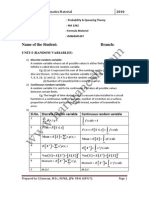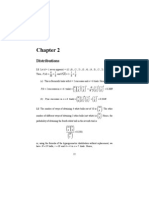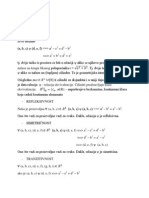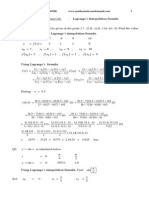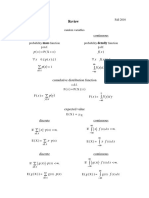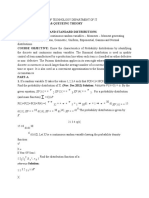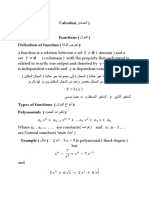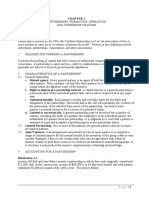Probability & Queuing Theory Formulas
Probability & Queuing Theory Formulas
Uploaded by
rahul.n90Copyright:
Available Formats
Probability & Queuing Theory Formulas
Probability & Queuing Theory Formulas
Uploaded by
rahul.n90Copyright
Available Formats
Share this document
Did you find this document useful?
Is this content inappropriate?
Copyright:
Available Formats
Probability & Queuing Theory Formulas
Probability & Queuing Theory Formulas
Uploaded by
rahul.n90Copyright:
Available Formats
PROBABILITY & QUEUING THEORY
UNIT-I (RANDOM VARIABLES)
1)
Discrete random variable:
Arandomvariablewhosesetofpossiblevaluesiseitherfiniteorcountably
infiniteiscalleddiscreterandomvariable.
Eg:(i)LetXrepresentthesumofthenumbersonthe2dice,whentwo
dicearethrown.InthiscasetherandomvariableXtakesthevalues2,3,4,5,6,
7,8,9,10,11and12.SoXisadiscreterandomvariable.
(ii)Numberoftransmittedbitsreceivedinerror.
2)
Continuous random variable:
ArandomvariableXissaidtobecontinuousifittakesallpossiblevalues
betweencertainlimits.
Eg:Thelengthoftimeduringwhichavacuumtubeinstalledinacircuit
functionsisacontinuousrandomvariable,numberofscratchesonasurface,
proportionofdefectivepartsamong1000tested,numberoftransmittedin
error.
3)
Sl.No. Discrete random variable Continuous random variable
1
( ) 1
i
i
p x
= = = =
= == =
( ) 1 f x dx
= == =
2
[ [[ [ ] ]] ] ( ) F x P X x = = = =
[ [[ [ ] ]] ] ( ) ( )
x
F x P X x f x dx
= = = = = = = =
3
[ [[ [ ] ]] ] Mean ( )
i i
i
E X x p x = = = = = = = =
[ [[ [ ] ]] ] Mean ( ) E X xf x dx
= = = = = = = =
4
2 2
( )
i i
i
E X x p x ( ( ( ( = == =
2 2
( ) E X x f x dx
( ( ( ( = == =
5
( (( ( ) )) ) ( (( ( ) )) ) ( (( ( ) )) )
2
2
Var X E X E X ( ( ( ( = = = =
( (( ( ) )) ) ( (( ( ) )) ) ( (( ( ) )) )
2
2
Var X E X E X ( ( ( ( = = = =
6
Moment=
r r
i i
i
E X x p ( ( ( ( = == =
Moment= ( )
r r
E X x f x dx
( ( ( ( = == =
7 M.G.F M.G.F
Formulas
LEARNLEGO.BLOGSPOT.COM
( (( ( ) )) ) ( )
tX tx
X
x
M t E e e p x ( ( ( ( = = = = = = = =
( (( ( ) )) ) ( )
tX tx
X
M t E e e f x dx
( ( ( ( = = = = = = = =
4) ( (( ( ) )) ) ( (( ( ) )) ) E aX b aE X b + = + + = + + = + + = +
5) ( (( ( ) )) ) ( (( ( ) )) )
2
Var Var aX b a X + = + = + = + =
6) ( (( ( ) )) ) ( (( ( ) )) ) ( (( ( ) )) )
2 2
Var Var aX bY a X b Var Y = + = + = + = +
7) ( (( ( ) )) ) Standard Deviation Var X = == =
8) ( ) ( ) f x F x = == =
9) ( ) 1 ( ) p X a p X a > = > = > = > =
10) ( (( ( ) )) )
( (( ( ) )) )
( (( ( ) )) )
/
p A B
p A B
p B
= == =
, ( (( ( ) )) ) 0 p B
11) IfAandBareindependent,then ( (( ( ) )) ) ( (( ( ) )) ) ( (( ( ) )) ) p A B p A p B = = = = .
12) 1
st
Momentaboutorigin= [ [[ [ ] ]] ] E X = ( (( ( ) )) )
0
X
t
M t
= == =
( ( ( (
(Mean)
2
nd
Momentaboutorigin=
2
E X ( ( ( (
= ( (( ( ) )) )
0
X
t
M t
= == =
( ( ( (
Theco-efficientof
!
r
t
r
=
r
E X ( ( ( (
(r
th
Momentabouttheorigin)
13) Limitation of M.G.F:
i) ArandomvariableXmayhavenomomentsalthoughitsm.g.fexists.
ii) ArandomvariableXcanhaveitsm.g.fandsomeorallmoments,yetthe
m.g.fdoesnotgeneratethemoments.
iii) ArandomvariableXcanhaveallorsomemoments,butm.g.fdoesnot
existexceptperhapsatonepoint.
14) Properties of M.G.F:
i) IfY=aX+b,then ( (( ( ) )) ) ( (( ( ) )) )
bt
Y X
M t e M at = == = .
ii) ( (( ( ) )) ) ( (( ( ) )) )
cX X
M t M ct = == = ,wherecisconstant.
iii) IfXandYaretwoindependentrandomvariablesthen
( (( ( ) )) ) ( (( ( ) )) ) ( (( ( ) )) )
X Y X Y
M t M t M t
+ ++ +
= = = = .
15) P.D.F,M.G.F,MeanandVarianceofallthedistributions:
Sl.
No.
Distributio
n
P.D.F ( ( ) P X x = == = )
M.G.F Mean Variance
1 Binomial x n x
x
nc p q
( (( ( ) )) )
n
t
q pe + ++ +
np npq
2 Poisson
!
x
e
x
( (( ( ) )) )
1
t
e
e
3 Geometric 1 x
q p
(or)
x
q p
1
t
t
pe
qe
1
p
2
q
p
LEARNLEGO.BLOGSPOT.COM
4 Negative
Binomial
1
( 1)
k x
k
x k C p p
+ + + +
1
k
t
p
qe
| | | | | | | |
| | | |
\ \ \ \
kq
p
2
kq
p
5 Uniform
1
,
( )
0, otherwise
a x b
f x b a
< < < < < < < <
= == =
( )
bt at
e e
b a t
2
a b + ++ +
2
( )
12
b a
6 Exponential
, 0, 0
( )
0, otherwise
x
e x
f x
> > > > > > > >
= == =
t
1
2
1
7 Gamma 1
( ) , 0 , 0
( )
x
e x
f x x
= < < > = < < > = < < > = < < >
1
(1 ) t
8 Weibull
1
( ) , 0, , 0
x
f x x e x
= > > = > > = > > = > >
16) Memorylesspropertyofexponentialdistribution
( (( ( ) )) ) ( (( ( ) )) ) / P X S t X S P X t > + > = > > + > = > > + > = > > + > = > .
UNIT-II (RANDOM VARIABLES)
1) 1
ij
i j
p = == =
(Discreterandomvariable)
( , ) 1 f x y dxdy
= == =
(Continuousrandomvariable)
2) ConditionalprobabilityfunctionXgivenY, { {{ { } }} }
( (( ( ) )) ) ,
/
( )
i i
P x y
P X x Y y
P y
= = = = = = = = = = = = .
ConditionalprobabilityfunctionYgivenX, { {{ { } }} }
( (( ( ) )) ) ,
/
( )
i i
P x y
P Y y X x
P x
= = = = = = = = = = = = .
{ {{ { } }} }
( (( ( ) )) ) ,
/
( )
P X a Y b
P X a Y b
P Y b
< < < < < < < <
< < = < < = < < = < < =
< << <
3) ConditionaldensityfunctionofXgivenY,
( , )
( / )
( )
f x y
f x y
f y
= == = .
ConditionaldensityfunctionofYgivenX,
( , )
( / )
( )
f x y
f y x
f x
= == = .
LEARNLEGO.BLOGSPOT.COM
4) IfXandYareindependentrandomvariablesthen
( , ) ( ). ( ) f x y f x f y = == = (forcontinuousrandomvariable)
( (( ( ) )) ) ( (( ( ) )) ) ( (( ( ) )) ) , . P X x Y y P X x P Y y = = = = = = = = = = = = = = = = = = = = (fordiscreterandomvariable)
5) Jointprobabilitydensityfunction ( (( ( ) )) ) , ( , )
d b
c a
P a X b c Y d f x y dxdy = = = =
.
( (( ( ) )) )
0 0
, ( , )
b a
P X a Y b f x y dxdy < < = < < = < < = < < =
6) MarginaldensityfunctionofX, ( ) ( ) ( , )
X
f x f x f x y dy
= = = = = = = =
MarginaldensityfunctionofY, ( ) ( ) ( , )
Y
f y f y f x y dx
= = = = = = = =
7) ( 1) 1 ( 1) P X Y P X Y + = + < + = + < + = + < + = + <
8) Correlation co efficient (Discrete):
( , )
( , )
X Y
Cov X Y
x y
= == =
1
( , ) Cov X Y XY XY
n
= = = =
,
2 2
1
X
X X
n
= = = =
,
2 2
1
Y
Y Y
n
= = = =
9) Correlation co efficient (Continuous):
( , )
( , )
X Y
Cov X Y
x y
= == =
( (( ( ) )) ) ( (( ( ) )) ) ( (( ( ) )) ) ( , ) , Cov X Y E X Y E X E Y = = = = , ( )
X
Var X = == = , ( )
Y
Var Y = == =
10) IfXandYareuncorrelatedrandomvariables,then ( , ) 0 Cov X Y = == = .
11) ( (( ( ) )) ) ( ) E X xf x dx
= == =
, ( (( ( ) )) ) ( ) E Y yf y dy
= == =
, ( (( ( ) )) ) , ( , ) E X Y xyf x y dxdy
= == =
.
12) Regression for Discrete random variable:
RegressionlineXonYis ( (( ( ) )) )
xy
x x b y y = = = = ,
( (( ( ) )) ) ( (( ( ) )) )
( (( ( ) )) )
2 xy
x x y y
b
y y
= == =
RegressionlineYonXis ( (( ( ) )) )
yx
y y b x x = = = = ,
( (( ( ) )) ) ( (( ( ) )) )
( (( ( ) )) )
2 yx
x x y y
b
x x
= == =
Correlationthroughtheregression, .
XY YX
b b = = = = Note: ( , ) ( , ) x y r x y = == =
LEARNLEGO.BLOGSPOT.COM
13) Regression for Continuous random variable:
RegressionlineXonYis ( (( ( ) )) ) ( ) ( )
xy
x E x b y E y = = = = ,
x
xy
y
b r
= == =
RegressionlineYonXis ( (( ( ) )) ) ( ) ( )
yx
y E y b x E x = = = = ,
y
yx
x
b r
= == =
RegressioncurveXonYis ( (( ( ) )) ) ( (( ( ) )) ) / / x E x y x f x y dx
= = = = = = = =
RegressioncurveYonXis ( (( ( ) )) ) ( (( ( ) )) ) / / y E y x y f y x dy
= = = = = = = =
14) Transformation Random Variables:
( ) ( )
Y X
dx
f y f x
dy
= == = (Onedimensionalrandomvariable)
( , ) ( , )
UV XY
u u
x y
f u v f x y
v v
x y
= == =
(Twodimensionalrandomvariable)
15) Central limit theorem (Liapounoffs form)
IfX
1
,X
2
,X
n
beasequenceofindependentR.VswithE[X
i
]=
i
andVar(X
i
)=
i
2
,i
=1,2,nandifS
n
=X
1
+X
2
++X
n
thenundercertaingeneralconditions,S
n
followsanormaldistributionwithmean
1
n
i
i
= == =
= == =
andvariance
2 2
1
n
i
i
= == =
= == =
as
n .
16) Central limit theorem (Lindberg Levys form)
IfX
1
,X
2
,X
n
beasequenceofindependentidenticallydistributedR.VswithE[X
i
]
=
i
andVar(X
i
)=
i
2
,i=1,2,nandifS
n
=X
1
+X
2
++X
n
thenundercertain
generalconditions,S
n
followsanormaldistributionwithmean n andvariance
2
n as n .
Note:
n
S n
z
n
= == = (fornvariables),
X
z
n
= == = (forsinglevariables)
LEARNLEGO.BLOGSPOT.COM
LEARNLEGO.BLOGSPOT.COM
UNIT-III (MARKOV PROCESSES AND MARKOV CHAINS)
1) Random Process:
Arandomprocessisacollectionofrandomvariables{X(s,t)}thatare
functionsofarealvariable,namelytimetwheresSandtT.
2) Classification of Random Processes:
Wecanclassifytherandomprocessaccordingtothecharacteristicsoftimet
andtherandomvariableX.WeshallconsideronlyfourcasesbasedontandX
havingvaluesintheranges-<t<and-<x<.
Continuousrandomprocess
Continuousrandomsequence
Discreterandomprocess
Discreterandomsequence
Continuous random process:
IfXandtarecontinuous,thenwecallX(t),aContinuousRandomProcess.
Example: IfX(t)representsthemaximumtemperatureataplaceinthe
interval(0,t),{X(t)}isaContinuousRandomProcess.
Continuous Random Sequence:
ArandomprocessforwhichXiscontinuousbuttimetakesonlydiscretevaluesis
calledaContinuousRandomSequence.
Example: IfX
n
representsthetemperatureattheendofthenthhourofaday,then
{X
n
,1n24}isaContinuousRandomSequence.
Discrete Random Process:
IfXassumesonlydiscretevaluesandtiscontinuous,thenwecallsuchrandom
process{X(t)}asDiscreteRandomProcess.
Example: IfX(t)representsthenumberoftelephonecallsreceivedintheinterval
(0,t)the{X(t)}isadiscreterandomprocesssinceS={0,1,2,3,...}
Discrete Random Sequence:
Arandomprocessinwhichboththerandomvariableandtimearediscreteis
calledDiscreteRandomSequence.
Example: IfX
n
representstheoutcomeofthenthtossofafairdie,the{X
n
:n1}isa
discreterandomsequence.SinceT={1,2,3,...}andS={1,2,3,4,5,6}
3) Condition for Stationary Process: [ [[ [ ] ]] ] ( ) Constant E X t = == = , [ [[ [ ] ]] ] ( ) constant Var X t = == = .
Iftheprocessisnotstationarythenitiscalledevolutionary.
4) Wide Sense Stationary (or) Weak Sense Stationary (or) Covariance Stationary:
ArandomprocessissaidtobeWSSorCovarianceStationaryifitsatisfiesthe
followingconditions.
i) Themeanoftheprocessisconstant(i.e) ( (( ( ) )) ) ( ) constant E X t = == = .
ii) Autocorrelationfunctiondependsonlyon (i.e)
[ [[ [ ] ]] ] ( ) ( ). ( )
XX
R E X t X t = + = + = + = +
5) Property of autocorrelation:
(i) ( (( ( ) )) ) ( (( ( ) )) )
2
( ) lim
XX
E X t R
( ( ( ( = == =
(ii)
( (( ( ) )) ) ( (( ( ) )) )
2
( ) 0
XX
E X t R = == =
6) Markov process:
Arandomprocessinwhichthefuturevaluedependsonlyonthepresentvalue
andnotonthepastvalues,iscalledamarkovprocess.Itissymbolically
representedby
1 1 1 1 0 0
( ) / ( ) , ( ) ... ( )
n n n n n n
P X t x X t x X t x X t x
+ + + + + + + +
= = = = = = = = = = = = ( ( ( (
1 1
( ) / ( )
n n n n
P X t x X t x
+ + + + + + + +
= = = = = = = = ( ( ( (
Where
0 1 2 1
...
n n
t t t t t
+ ++ +
7) Markov Chain:
Ifforall n,
1 1 2 2 0 0
/ , , ...
n n n n n n
P X a X a X a X a
= = = = = = = = = = = = = = = = ( ( ( (
1 1
/
n n n n
P X a X a
= = = = = = = = = = = = ( ( ( (
thentheprocess { {{ { } }} }
n
X , 0,1, 2, ... n = == = iscalledthemarkovchain.Where
0 1 2
, , , ... , ...
n
a a a a arecalledthestatesofthemarkovchain.
8) Transition Probability Matrix (tpm):
WhentheMarkovChainishomogenous,theonesteptransitionprobabilityis
denotedbyP
ij
.ThematrixP={P
ij
}iscalledtransitionprobabilitymatrix.
9) Chapman Kolmogorov theorem:
IfPisthetpmofahomogeneousMarkovchain,thenthensteptpmP
(n)
is
equaltoP
n
.(i.e)
( )
n
n
ij ij
P P ( ( ( ( = == =
.
10) Markov Chain property:If ( (( ( ) )) )
1 2 3
, , = = = = ,then P = = = = and
1 2 3
1 + + = + + = + + = + + = .
11) Poisson process:
If ( ) X t representsthenumberofoccurrencesofacertaineventin (0, ) t ,then
thediscreterandomprocess { {{ { } }} } ( ) X t iscalledthePoissonprocess,providedthe
followingpostulatesaresatisfied.
LEARNLEGO.BLOGSPOT.COM
(i) [ [[ [ ] ]] ] ( (( ( ) )) ) 1 occurrence in ( , ) P t t t t O t + = + + = + + = + + = +
(ii) [ [[ [ ] ]] ] ( (( ( ) )) ) 0 occurrence in ( , ) 1 P t t t t O t + = + + = + + = + + = +
(iii) [ [[ [ ] ]] ] ( (( ( ) )) ) 2 or more occurrences in ( , ) P t t t O t + = + = + = + =
(iv) ( ) X t isindependentofthenumberofoccurrencesoftheeventinany
interval.
12) Probability law of Poisson process: { {{ { } }} }
( (( ( ) )) )
( ) , 0,1, 2, ...
!
n
t
e t
P X t n n
n
= = = = = = = = = = = =
Mean [ [[ [ ] ]] ] ( ) E X t t = == = ,
2 2 2
( ) E X t t t ( ( ( ( = + = + = + = +
, [ [[ [ ] ]] ] ( ) Var X t t = == = .
UNIT-IV (QUEUEING THEORY)
nNumberofcustomersinthesystem.
Meanarrivalrate.
Meanservicerate.
n
P SteadyStateprobabilityofexactlyncustomersinthesystem.
q
L Averagenumberofcustomersinthequeue.
s
L Averagenumberofcustomersinthesystem.
q
W Averagewaitingtimepercustomerinthequeue.
s
W Averagewaitingtimepercustomerinthesystem.
Model I (M / M / 1): ( / FIFO)
1) ServerUtilization
= == =
2) ( (( ( ) )) ) 1
n
n
P = = = = (P
0
nocustomersinthesystem)
3)
1
s
L
= == =
4)
2
1
q
L
= == =
5)
( (( ( ) )) )
1
1
s
W
= == =
LEARNLEGO.BLOGSPOT.COM
6)
( (( ( ) )) ) 1
q
W
= == =
7) Probabilitythatthewaitingtimeofacustomerinthesystemexceedstis
( )
( )
t
s
P w t e
> = > = > = > = .
8) Probabilitythatthequuesizeexceedstis ( (( ( ) )) )
1 n
P N n
+ ++ +
> = > = > = > = where
1 n t = + = + = + = + .
Model II (M / M / C): ( / FIFO)
1)
s
= == =
2)
( (( ( ) )) ) ( (( ( ) )) )
( (( ( ) )) )
1
1
0
0
! ! 1
n s
s
n
s s
P
n s
= == =
( ( ( (
( ( ( ( = + = + = + = +
( ( ( (
3)
( (( ( ) )) )
( (( ( ) )) )
1
0 2
1
. !
1
s
q
s
L P
s s
+ ++ +
= == =
4)
s q
L L s = + = + = + = +
5)
q
q
L
W
= == =
6)
s
s
L
W
= == =
7) Theprobabilitythatanarrivalhastowait: ( (( ( ) )) )
( (( ( ) )) )
( (( ( ) )) )
0
! 1
s
s
P N s P
s
= = = =
8) Theprobabilitythatanarrivalenterstheservicewithoutwaiting=1P(an
arrivalhattowait)= ( (( ( ) )) ) 1 P N s
9) ( (( ( ) )) )
( 1 )
0
( ) 1
1
!(1 )( 1 )
s t s s
t
s e
P w t e P
s s s
( ( ( (
> = + > = + > = + > = +
` ` ` `
) ) ) )
Model III (M / M / 1): (K / FIFO)
1)
= == =
LEARNLEGO.BLOGSPOT.COM
2)
0 1
1
1
k
P
+ ++ +
= == =
(Nocustomer)
3) ( (( ( ) )) )
0
1 P = = = = (effectivearrivalrate)
4)
( (( ( ) )) )
1
1
1
1 1
k
s k
k
L
+ ++ +
+ ++ +
+ ++ +
= = = =
5)
q s
L L
= = = =
6)
s
s
L
W
= == =
7)
q
q
L
W
= == =
8) [ [[ [ ] ]] ]
0
a customer turned away
k
k
P P P = = = = = = = =
Model IV (M / M / C): (K / FIFO)
1)
s
= == =
2)
( (( ( ) )) ) ( (( ( ) )) )
1
1
0
0
! !
n s
s k
n s
n n s
s s
P
n s
= = = = = = = =
( ( ( (
( ( ( ( = + = + = + = +
( ( ( (
3)
( (( ( ) )) )
( (( ( ) )) )
0
0
,
!
,
!
n
n
n
n s
s
P n s
n
P
s
P s n k
s s
= == =
4) Effectivearrivalrate: ( (( ( ) )) )
1
0
s
n
n
s s n P
= == =
( ( ( (
= = = =
( ( ( (
5)
( (( ( ) )) ) ( (( ( ) )) )
( (( ( ) )) )
( (( ( ) )) )
1
0 2
1
! 1
1
s k s
k s
q
s k s
L P
s
+ + + +
( ( ( (
( ( ( ( = = = =
( ( ( (
6)
s q
L L
= + = + = + = +
7)
q
q
L
W
= == =
LEARNLEGO.BLOGSPOT.COM
8)
s
s
L
W
= == =
UNIT-V (NON MARKOVIAN & QUEUEING NETWORK)
1) Pollaczek Khintchine formula:
( (( ( ) )) )
[ [[ [ ] ]] ]
2
2
( ) ( )
( )
2 1 ( )
S
Var t E t
L E t
E t
( ( ( (
+ ++ +
= + = + = + = +
(or)
( (( ( ) )) )
2 2 2
2 1
S
L
+ ++ +
= + = + = + = +
2) Littles formulas:
( (( ( ) )) )
2 2 2
2 1
S
L
+ ++ +
= + = + = + = +
q S
L L = = = =
S
S
L
W
= == =
q
q
L
W
= == =
3) Series queue (or) Tandem queue:
Thebalanceequation
00 2 01
P P = == =
1 10 00 2 11
P P P = + = + = + = +
01 2 01 1 10 2 1 b
P P P P + = + + = + + = + + = +
1 11 2 11 01
P P P + = + = + = + =
2 1 1 11 b
P P = == =
Condition
00 10 01 11 1
1
b
P P P P P + + + + = + + + + = + + + + = + + + + =
4) Open Jackson networks:
i) Jacksonsflowbalanceequation
1
k
j j i ij
i
r P
= == =
= + = + = + = +
LEARNLEGO.BLOGSPOT.COM
Whereknumberofnodes,r
j
customersfromoutside
ii) Jointsteadystateprobabilities
( (( ( ) )) ) ( (( ( ) )) ) ( (( ( ) )) ) ( (( ( ) )) )
1 2
1 2 1 1 2 2
, , ... 1 1 ... 1
k
n n n
k k k
P n n n = = = =
iii) Averagenumberofcustomersinthesystem
1 2
1 2
...
1 1 1
k
S
k
L
= + + + = + + + = + + + = + + +
iv) Averagewaitingtimeofacustomersinthesystem
S
S
L
W
= == = where
1 2
...
k
r r r = + + + = + + + = + + + = + + +
5) Closed Jackson networks:
Intheclosednetwork,therearenocustomersfromoutside,therefore 0
j
r = == =
then
i) TheJacksonsflowbalanceequation
1
k
j i ij
i
P
= == =
= == =
0
j
r = == =
(or)
( (( ( ) )) ) ( (( ( ) )) )
11 12 1
2 21 22
1 2 1 2
1 2
...
...
... ...
...
k
k
k k
k k kk
P P P
P P P
P P P
| | | | | | | |
| | | |
| | | |
= == =
| | | |
| | | |
| | | |
\ \ \ \
ii) Ifeachnodessingleserver
( (( ( ) )) )
1 2
1 2 1 2
, , ... ...
k
n n n
k N k
P n n n C = == =
Where
1 2
1 2
1
1 2
...
...
k
k
n n n
N k
n n n N
C
+ + + = + + + = + + + = + + + =
= == =
iii) Ifeachnodeshasmultipleservers
( (( ( ) )) )
1 2
1 2
1 2
1 2
, , ... ...
k
n n n
k
k N
k
P n n n C
a a a
= == =
Where
1 2
1 2
1 1 2
...
1 2
...
k
k
n n n
k
N
n n n N
k
C
a a a
+ + + = + + + = + + + = + + + =
= == =
LEARNLEGO.BLOGSPOT.COM
! ,
! ,
i i
i i i
i
n s
i i i i
n n s
a
s s n s
< << <
= == =
LEARNLEGO.BLOGSPOT.COM
You might also like
- Math102 Equation SheetDocument0 pagesMath102 Equation SheetMaureen LaiNo ratings yet
- Challinor - Debunking STDocument6 pagesChallinor - Debunking STLyra Loh Hui Min100% (1)
- 2008 Taxation Law Bar QuestionsDocument4 pages2008 Taxation Law Bar QuestionsMowan100% (1)
- QuickStudy Resumes & Interviews PDFDocument4 pagesQuickStudy Resumes & Interviews PDFJohn100% (3)
- Extraction and Recrystallization of CaffeineDocument3 pagesExtraction and Recrystallization of CaffeineTommy BetyNo ratings yet
- Probability & Random Process: FormulasDocument10 pagesProbability & Random Process: FormulasvrsafeNo ratings yet
- Name of The Student: Branch:: Engineering Mathematics Material 2010Document13 pagesName of The Student: Branch:: Engineering Mathematics Material 2010krrmallikaNo ratings yet
- PRP NotesDocument10 pagesPRP NotesBharath JojoNo ratings yet
- Chapter 6F-PropCRV - W PDFDocument30 pagesChapter 6F-PropCRV - W PDFaltwirqiNo ratings yet
- My Distributions Ptest - 1Document6 pagesMy Distributions Ptest - 1Jeremy MartinNo ratings yet
- R LN ExpDocument1 pageR LN ExpAbderrazak BlNo ratings yet
- System of Non Linear EquationsDocument16 pagesSystem of Non Linear EquationsAriadne ChuaNo ratings yet
- f (x) f (0) x lim lim 1 x0 x f (x) f (0) x lim lim 1 x0 x y Μ (ξ,f (ξ) ) Β (β,f (β) ) Α (α,f (α) )Document4 pagesf (x) f (0) x lim lim 1 x0 x f (x) f (0) x lim lim 1 x0 x y Μ (ξ,f (ξ) ) Β (β,f (β) ) Α (α,f (α) )margkosNo ratings yet
- Chapter 02Document13 pagesChapter 02Sudipta GhoshNo ratings yet
- Linearna Algebra - Rjesenja, ETFDocument44 pagesLinearna Algebra - Rjesenja, ETFmarkovukNo ratings yet
- Fourier SeriesDocument26 pagesFourier SeriesPurushothamanNo ratings yet
- Functions Ex.2 (B)Document20 pagesFunctions Ex.2 (B)Gokul NathNo ratings yet
- Math ReferenceDocument24 pagesMath ReferenceSujib BarmanNo ratings yet
- Formula2 (1) UpdatedDocument3 pagesFormula2 (1) UpdatedAmm RoehNo ratings yet
- CHAPTER 2. Random VariableDocument26 pagesCHAPTER 2. Random VariableNhư QuỳnhNo ratings yet
- Chapter 6Document28 pagesChapter 6Sahand NoorizadehNo ratings yet
- Joint DistributionsDocument9 pagesJoint Distributionschacha_420No ratings yet
- $ Sem5 - Maths FormulaeDocument3 pages$ Sem5 - Maths FormulaeParth CholeraNo ratings yet
- Limit ContinuiTY Differential ASSIGNMENT FOR IIT-JEEDocument17 pagesLimit ContinuiTY Differential ASSIGNMENT FOR IIT-JEEApex Institute100% (2)
- Rumus Matematika Sma InterDocument19 pagesRumus Matematika Sma InterAde JayusNo ratings yet
- ch2. Linear Least Mean Squared Error (LLMSE, MMSE) FilterDocument18 pagesch2. Linear Least Mean Squared Error (LLMSE, MMSE) FilterKyusang ParkNo ratings yet
- Mathematical Expectation and OthersDocument17 pagesMathematical Expectation and Othersasif mahmudNo ratings yet
- fatima husseinDocument14 pagesfatima husseinblvkrosezNo ratings yet
- Lagrange and Hermite Interpolation 1Document10 pagesLagrange and Hermite Interpolation 1Aditya KataraNo ratings yet
- X Senx Senx y DX Dy X X DZ Xtagx DX Dy: Cos 2 Cos 1Document3 pagesX Senx Senx y DX Dy X X DZ Xtagx DX Dy: Cos 2 Cos 1Gabriel Irigoin CordovaNo ratings yet
- Problem TPDEDocument8 pagesProblem TPDEGowtham RajNo ratings yet
- Osnovna Pravila DiferenciranjaDocument2 pagesOsnovna Pravila DiferenciranjafehimfehaNo ratings yet
- PQT FormulaDocument13 pagesPQT FormulalogeshnandaNo ratings yet
- 07 - HW Extrema Inflection ProblemsDocument5 pages07 - HW Extrema Inflection Problemskv.vladislav.vNo ratings yet
- Department of Mathematics, IIT Kharagpur MA10002: Mathematics-II Assignment-1 On Integral CalculusDocument2 pagesDepartment of Mathematics, IIT Kharagpur MA10002: Mathematics-II Assignment-1 On Integral CalculusSidMadharchodNo ratings yet
- Limits: Calculus Cheat SheetDocument7 pagesLimits: Calculus Cheat SheetPratiksh PatelNo ratings yet
- Formula For TPDEDocument11 pagesFormula For TPDEGowtham Raj100% (2)
- Booklet 19.downloadDocument3 pagesBooklet 19.downloadHila Neuberger RiterNo ratings yet
- Rhyne Mixzanry Magesarey L. Rodriguez 11 - Galatians Module 1: Derivatives and Its Application Summative AssesmentDocument5 pagesRhyne Mixzanry Magesarey L. Rodriguez 11 - Galatians Module 1: Derivatives and Its Application Summative AssesmentAlex RodriguezNo ratings yet
- Introduction To ROBOTICS: Velocity Analysis JacobianDocument32 pagesIntroduction To ROBOTICS: Velocity Analysis Jacobianal7123No ratings yet
- 09 03 Parametric Differentiation PDFDocument28 pages09 03 Parametric Differentiation PDFSri D100% (1)
- Integrarea Prin PartiDocument2 pagesIntegrarea Prin PartiMitru CarmenNo ratings yet
- Ath em Ati CS: L.K .SH Arm ADocument6 pagesAth em Ati CS: L.K .SH Arm APremNo ratings yet
- Chapter 19 Numerical Differentiation: Taylor Polynomials Lagrange InterpolationDocument29 pagesChapter 19 Numerical Differentiation: Taylor Polynomials Lagrange InterpolationIbrar NasirNo ratings yet
- SolutionDocument3 pagesSolutiontnmnhnguyenNo ratings yet
- Mathematics CalculusDocument11 pagesMathematics CalculusAnish NaniNo ratings yet
- NYJC JC 2 H2 Maths 2011 Mid Year Exam Solutions Paper 1Document10 pagesNYJC JC 2 H2 Maths 2011 Mid Year Exam Solutions Paper 1jimmytanlimlongNo ratings yet
- Review1 PDFDocument22 pagesReview1 PDFdNo ratings yet
- Maths FormulaDocument4 pagesMaths Formulamickey_disney93No ratings yet
- Integrales Por Partes: Ax Ax Ax Ax AxDocument4 pagesIntegrales Por Partes: Ax Ax Ax Ax AxIsaac Isaias AlvarezNo ratings yet
- 7A Definite IntegrationDocument51 pages7A Definite IntegrationSri DNo ratings yet
- PQT PDFDocument113 pagesPQT PDFchandu pandhareNo ratings yet
- 3 Discrete Random Variables and Probability DistributionsDocument26 pages3 Discrete Random Variables and Probability DistributionsRenukadevi RptNo ratings yet
- Math 1Document86 pagesMath 1Naji ZaidNo ratings yet
- Lecture # 3 Derivative of Polynomials and Exponential Functions Dr. Ghada AbdelhadyDocument32 pagesLecture # 3 Derivative of Polynomials and Exponential Functions Dr. Ghada AbdelhadyEsraa AhmadNo ratings yet
- Random Variables: BY T. Nandana Jyothi Asst. Prof, Dept of EEE K L UniversityDocument10 pagesRandom Variables: BY T. Nandana Jyothi Asst. Prof, Dept of EEE K L UniversitykanagalasasankNo ratings yet
- Differentiation (Calculus) Mathematics Question BankFrom EverandDifferentiation (Calculus) Mathematics Question BankRating: 4 out of 5 stars4/5 (1)
- Trigonometric Ratios to Transformations (Trigonometry) Mathematics E-Book For Public ExamsFrom EverandTrigonometric Ratios to Transformations (Trigonometry) Mathematics E-Book For Public ExamsRating: 5 out of 5 stars5/5 (1)
- Mathematics 1St First Order Linear Differential Equations 2Nd Second Order Linear Differential Equations Laplace Fourier Bessel MathematicsFrom EverandMathematics 1St First Order Linear Differential Equations 2Nd Second Order Linear Differential Equations Laplace Fourier Bessel MathematicsNo ratings yet
- De Moiver's Theorem (Trigonometry) Mathematics Question BankFrom EverandDe Moiver's Theorem (Trigonometry) Mathematics Question BankNo ratings yet
- Inverse Trigonometric Functions (Trigonometry) Mathematics Question BankFrom EverandInverse Trigonometric Functions (Trigonometry) Mathematics Question BankNo ratings yet
- 1 Chapter 1 Partnership FormationDocument16 pages1 Chapter 1 Partnership FormationJymldy EnclnNo ratings yet
- Thalassemia Final Seminar by Sachin DwivediDocument51 pagesThalassemia Final Seminar by Sachin DwivediSachin DwivediNo ratings yet
- Communicating Authentic Assessments Result: Written Report in Assessment of Learning 2Document21 pagesCommunicating Authentic Assessments Result: Written Report in Assessment of Learning 2Grace Ann Aquino100% (1)
- Ancient Sky-map From MudumalDocument4 pagesAncient Sky-map From MudumalVenkata Chennarao BondalapatiNo ratings yet
- Universidad Abierta para Adultos: (Uapa)Document5 pagesUniversidad Abierta para Adultos: (Uapa)Pablo LopezNo ratings yet
- Old ThesisDocument8 pagesOld Thesisgjaj8vvw100% (2)
- Mihály Mellár: Post System of The Magyar Language 3Document12 pagesMihály Mellár: Post System of The Magyar Language 3anzumadarNo ratings yet
- All Simple Past For Grade 7Document6 pagesAll Simple Past For Grade 7me IamNo ratings yet
- T/Ghazwat-e-Nabwi PBUH - Major Battles of Prophet Muhammad - PDFDocument25 pagesT/Ghazwat-e-Nabwi PBUH - Major Battles of Prophet Muhammad - PDFshanza fatimaNo ratings yet
- Abul Hassan Haveli Case StudyDocument10 pagesAbul Hassan Haveli Case StudyAyush RawatNo ratings yet
- Brahmanical Shies Over Angkor TemplesDocument89 pagesBrahmanical Shies Over Angkor TemplesUday DokrasNo ratings yet
- Key Risk Indicators: 13 - 16 December 2009, Abu Dhabi, UaeDocument6 pagesKey Risk Indicators: 13 - 16 December 2009, Abu Dhabi, UaeAneuxAgamNo ratings yet
- Lesson Plan NounsDocument2 pagesLesson Plan NounsRocoBabe's PPTNo ratings yet
- Give The Scientific Name of The Dog Family. 2. Name Five Distinctive Characteristics of The Dog FamilyDocument71 pagesGive The Scientific Name of The Dog Family. 2. Name Five Distinctive Characteristics of The Dog FamilyJun Siguenza AmbrocioNo ratings yet
- Haiti Banking Clinton-Foundation & US-RevolutionsDocument3 pagesHaiti Banking Clinton-Foundation & US-RevolutionsYoav NetzerNo ratings yet
- Complete Work ImmersionDocument49 pagesComplete Work ImmersionMarielle RumbaoaNo ratings yet
- Module 3 Nursing Skills Procedure On GI, Endo-Metab Concept (A)Document18 pagesModule 3 Nursing Skills Procedure On GI, Endo-Metab Concept (A)Nashebah A. BatuganNo ratings yet
- Pepsi-Cola v. Secretary of Labor-2Document11 pagesPepsi-Cola v. Secretary of Labor-2SophiaFrancescaEspinosaNo ratings yet
- 1st Periodical Test - Values 4Document5 pages1st Periodical Test - Values 4Annie LynNo ratings yet
- SM 2Document93 pagesSM 2RU ShenoyNo ratings yet
- National Income AccountingDocument26 pagesNational Income AccountingAnifahchannie PacalnaNo ratings yet
- How Are Things?: Real Listening and Speaking 3 by Miles CravenDocument16 pagesHow Are Things?: Real Listening and Speaking 3 by Miles CravenkadpoortNo ratings yet
- Talking About A New ProjectDocument4 pagesTalking About A New ProjectAngela AlqueroNo ratings yet
- 7) Classes and Instances Find The Three Elements That Sum To Zero From A Set of N Real NumbersDocument3 pages7) Classes and Instances Find The Three Elements That Sum To Zero From A Set of N Real Numbers18bcs097 M. SanthiyaNo ratings yet
- OB Assignment-1Document10 pagesOB Assignment-1Redwanur RahmanNo ratings yet
- Joshua M Standifer ResumeDocument1 pageJoshua M Standifer Resumeapi-215672183No ratings yet






